Some Interesting Malesian Hybrids
Arthur W. Headlam, Bentleigh, Australia
The first Malesian rhododendron raised in Australia was
R. christianae
, and as one may well have expected, hybridists were soon at work.
R. christianae
was crossed with
R. lochiae
, the only rhododendron indigenous to Australia. Seed was germinated and plants were grown on and it was with considerable interest that the first flowers were awaited. However,
R. lochiae
proved to be the dominant parent and this pattern has generally followed with subsequent hybrids, particularly in regard to color.
It was my very good friend, Brian Clancy, who decided to persevere with
R. lochiae
and he eventually selfed his
R. christianae
x
R. lochiae
hybrid, thus producing the F2 progeny with some what startling results. The flowers were much larger some with filled edges and pleasingly, extended over a much wider range of colors, from pale pink flushed with salmon through the intermediate shades to a bright red. Out of a batch of plants I mentioned my preference for the one in the bright red toning, which glowed particularly when viewed in the sunlight. On my next visit to his garden I noticed that it carried the name tag 'Arthur's Choice'.
The second generation progeny of the hybrid
R. christianae
x
R. lochiae
are a decided improvement upon their parents. The flowers are much larger, two and one half inches across the lobes, and carry up to ten flowers to the truss. They are of greater substance, whilst the leaves are greener and more leathery. The F2 is easier to strike and easier to grow. It is free flowering and the flowers are carried for a much longer period.
A popular rhododendron in Australia is 'Pink Delight', one of the many hybrids produced by the famous English nursery of Veitch almost one hundred years ago. It was described and illustrated in the ARS Bulletin, Vol. 27, No. 1.
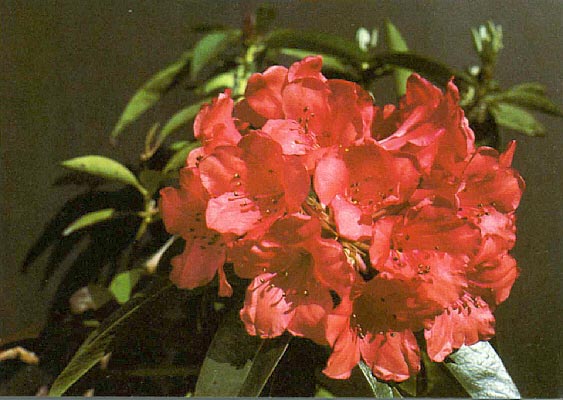
|
|
R. 'Souvenir of J. H. Mangles'
Photo by Arthur Headlam |
Another Veitch hybrid which may well push 'Pink Delight' from the top of the list is 'Souvenir of J. H. Mangles', which was awarded the F.C.C. in 1888. I am again indebted to Brian Clancy for making his plant available to photograph, firstly in the early stages with its nineteen orange-red buds, which caused considerable interest and speculation as to the final result, and eventually when the flowers were fully opened, a beautiful spherical truss of coppery red (R .H. S. Color Chart Red Group 41 D). It fully came up to all expectations. The color no doubt was influenced by the inclusion of
R. brookeanum
var.
gracile
once and
R. javanicum
twice in its lineage. It has the added advantage of striking readily from cuttings and producing flowers at an early age.
Although the title of this article refers to Interesting Malesian Hybrids, one must not lose sight of the fact that not all hybrids are man made. Dr. Herman Sleumer in his monumental work,
An Account of Rhododendron in Malesia
, describes quite a number of natural hybrids in parts of New Guinea, e.g., sixteen species in the Mt. Wilhelm area as well as seven local hybrids in the same area.
From a batch of approximately one hundred seedlings of
R. phaeopeplum
raised in Australia, one obvious hybrid appeared and this was eventually identified as being between
R. phaeopeplum
and
R. zoelleri
. It was subsequently named 'Dr. Herman Sleumer'. The tubular funnel shaped flowers, creamy yellow in the tube with deep pink flared lobes (R. H. S. Color Chart Red 51A, fading to center, tube Yellow/Cream 1508), carry a carnation like perfume. Foliage is intermediate between the two, and it carries four to six flowers to the truss, with five, six and seven lobes. I find it fairly easy to grow, and my plant in a fern log, now five years of age is shooting vigorously from the base.
The cross
R. laetum
x
R. phaeopeplum
was made by Dr. R. M. Withers, and although not really a vigorous grower, produces quite a profusion of funnel shaped flowers three inches across the lobes, cream with a deep pink flare on the margins. There are five, six and sometimes seven lobes to the flowers which may have 9, 10 or 11 stamens. The juvenile foliage distinctly resembles that of
R. phaeopeplum
, and as it matures loses its rusty brown tomentum and becomes more like that of
R. laetum
, or intermediate between the two.
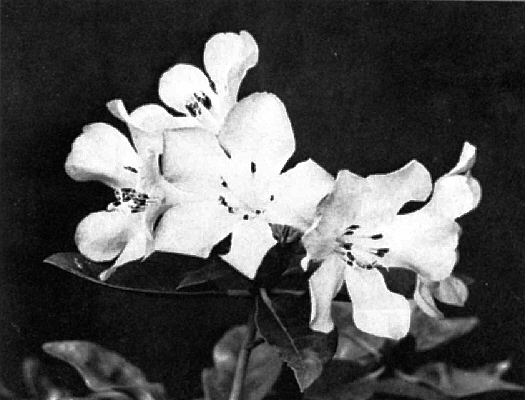
|
|
R. 'Dr. Herman Sleumer'
Photo by Arthur Headlam |
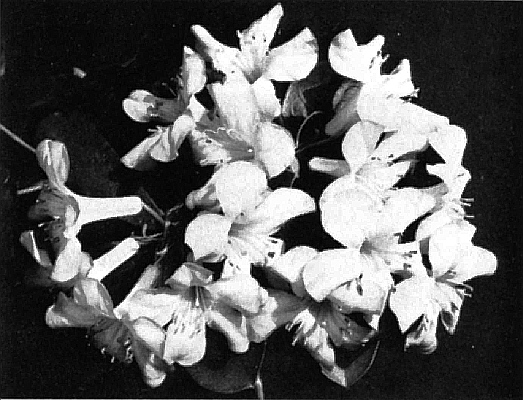
|
|
R. laetum
x
R. phaeopeplum
Photo by Arthur Headlam |
Another cross by Dr. Withers is R. laetum x R. gracilentum , which produced quite different results from what one may have expected. In fact, it is purely an enlarged version of R. gracilentum in both foliage and flowers. It does however, have many advantages over R. gracilentum in as much as it is easy to propagate, is free flowering and carries a few flowers at odd times throughout the year. The color of the flowers closely resembles that of R. gracilentum . There is nothing to indicate in any way that R. laetum is part of the cross.
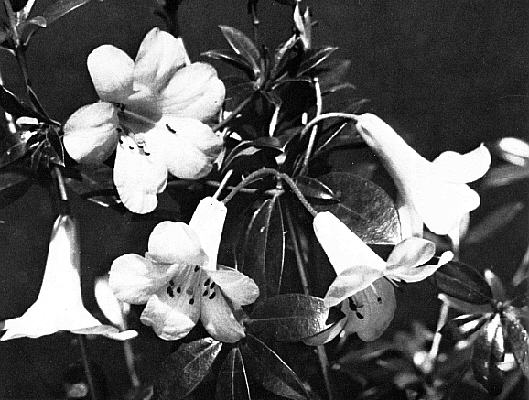
|
|
R. laetum
x
R. gracilentum
Photo by Arthur Headlam |
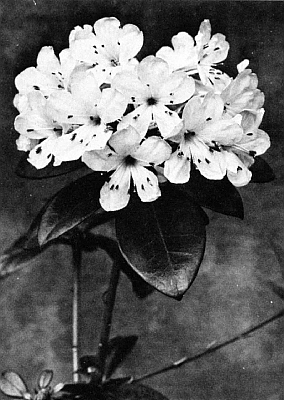
|
|
R. laetum
x
R. macgregoriae
Photo by A. Headlam |
R. laetum
x
R. macgregoriae
, raised by Brian Clancy in 1970, is an example of a hybrid bearing very definite characteristics of both parents. The plant given to me produced a large, elliptical-shaped bud some two inches in length and it eventually unfolded with twenty flowers of a pale yellow color, gradually deepening in intensity and when fully opened they were a deep yellow flushed orange at the margins of the lobes. The narrow- tubes were three quarters of an inch in length and the flowers measured two inches across the lobes. The red pedicels 1½ inches in length resulted in the flowers remaining quite erect, making an extremely attractive spherical shaped truss which glowed particularly when the sun shone on it.
To sum up, it may be said that
R. christianae
x
R. lochiae
F2 is a decided improvement on both parents, 'Souvenir of J. H. Mangles' is a very striking rhododendron and although it has been in cultivation in Australia for quite a number of years, it is only recently that it is becoming more readily available. 'Dr. Herman Sleumer' is an example of a very attractive natural hybrid.
R. laetum
x
R. phaeopeplum
has inherited distinct characteristics of both parents.
R. laetum
x
R. gracilentum
is an enlarged version of
R. gracilentum
and gives no indication of having
R. laetum
in its make up. And finally,
R. laetum
x
R. macgregoriae
appears to have inherited some of the best characteristics of both parents.